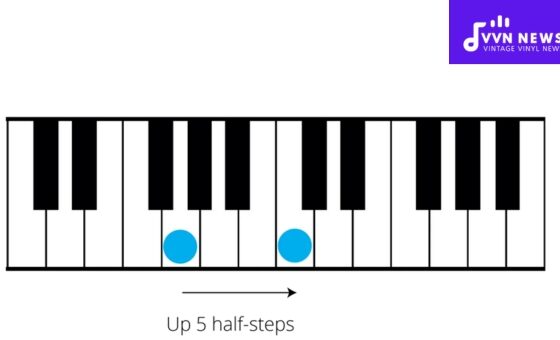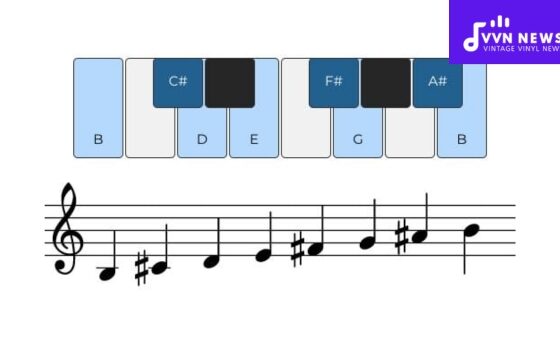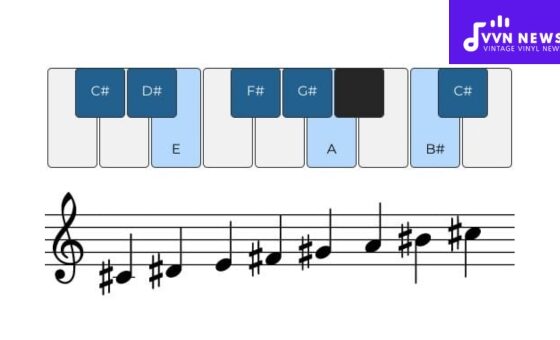If you’ve ever tapped your foot to a soulful guitar solo or found yourself captivated by the raw emotion in a blues singer’s voice, there’s a good chance you’ve felt the power of the A minor blues scale at work.
This scale is a cornerstone of not only blues music but also an essential element in jazz, rock, and even pop genres. Understanding how to use it can unlock a world of expressive potential in your playing.
The A minor blues scale might seem like a small piece of the vast musical puzzle, but its impact is significant.
It possesses a depth that belies its simplicity, offering musicians a versatile toolkit for improvisation and melody construction.
Whether you’re looking to add some smoky nuances to your guitar licks or enliven your keyboard solos with a touch of bluesy flair, getting familiar with this scale will serve you well on your musical journey.
Composition of the A Minor Blues Scale
The A Minor Blues Scale is a musical pattern consisting of six notes that create its distinct, evocative sound.
It’s derived by adding a flatted fifth, commonly known as the “blue note,” to the regular A minor pentatonic scale. Here’s the scale in all its glory:
- A (Root)
- C (Minor Third)
- D (Fourth)
- D# (Flatted Fifth or The Blue Note)
- E (Fifth)
- G (Minor Seventh)
These notes collectively paint the poignant picture that is characteristic of blues music.
As you play through this sequence, the transition between the D and E, with D# nestled in between, imparts an unmistakable tension and release—a hallmark feature in blues improvisation.
Whether plucking these notes on bass strings or bending them on a guitar fretboard, their arrangement offers musicians rich avenues for soulful expressions.
Also Read: 24 Best Chorus Pedals In 2024 [Deliver A Rich & Wide Guitar Sound]
How is the A Minor Blues Scale Formulated?
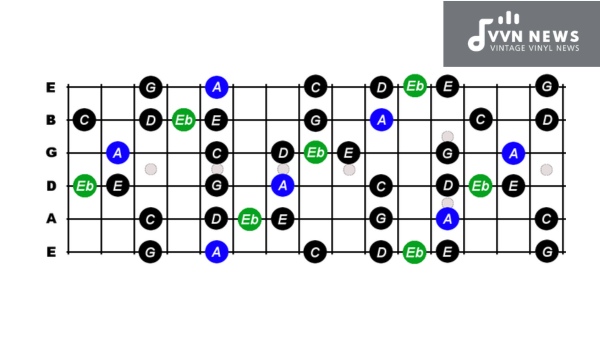
Implementing these three steps gives you the foundation to master the A Minor Blues Scale.
Establish the Natural A Minor Scale
Begin with the structure of the natural A minor scale: A, B, C, D, E, F, and G.
This scale is built from a straightforward sequence of whole and half steps – whole, half, whole, whole, half, and encompasses an octave from A to A.
Add The Flat-Five
The defining characteristic of blues music is its expressive “blue notes”. In creating an A minor blues scale, weave in an E-flat (Eb) or flat-five amidst the natural minor framework.
This addition crafts a distinctly bluesy sound within your scale.
Formulate The Pentatonic Core
The minor blues scale essentially modifies the minor pentatonic scale by including one additional note.
So take your pentatonic base – A, C, D, E, and G – then insert your blue note Eb between D and E. Now you have your six-note blues scale: A-C-D-Eb-E-G.
Embrace these steps to forge your path through the emotive landscape of blues music.
The A Minor Blues Scale waits to be explored with its gritty texture and evocative melodies synonymous with timeless musical storytelling.
Also Read: 20 Best Eq Pedals For Perfect Tone [Shape Your Guitar Sound]
What Are the Various Positions for Playing the A Minor Blues Scale?
When diving into the A minor blues scale, you’ll discover that it can be played in five main shapes or positions on the fretboard.
These shapes allow guitarists to weave through the scale across different octaves and areas of the neck.
The Open Position
Here, we start with the open strings as our foundation:
- A (open 5th string)
- C (3rd fret, 5th string)
- D (open 4th string)
- Eb (1st fret, 4th string – also known as ‘the blue note’)
- E (2nd fret, 4th string)
- G (open 3rd string)
This position is excellent for beginners because it’s grounded in open strings and first-position notes.
The Box Pattern
The second shape, commonly referred to as “the box pattern,” spans from the 5th to the 8th fret:
- Start at A (5th fret, 6th string)
This area is favored due to its comfortable hand positioning and accessibility during solos.
The Classic Bend
Centered around the bendable notes on the G string:
- Initiate at C (8th fret, 6th string)
This zone opens up expressive bending opportunities particularly resonant in blues music.
The Two-Octave Stretch
Extending from the root note on the D string:
- Begin at A (7th fret, D String)
Musicians revel in this layout since it spans two octaves which yields a plethora of melodic options and dynamic phrasing capabilities.
The High Register Glide
Dominating the highest register of standard tuning:
- The starting point is a high A (10th fret B String)
Perfect for culminating a fiery solo or accenting high-frequency licks that cut through any mix.
By familiarizing yourself with each shape and its place on your instrument’s neck, you gain flexibility and fluidity in your playing.
Integrating these shapes will not only embellish your musical vocabulary but also provide seamless transitions mid-improvisation.
Also Read: 25 Best 80’s Female Singers [Remembering The Icons Of Pop Music]
Comparing A Minor Blues Scales: Major vs. Minor
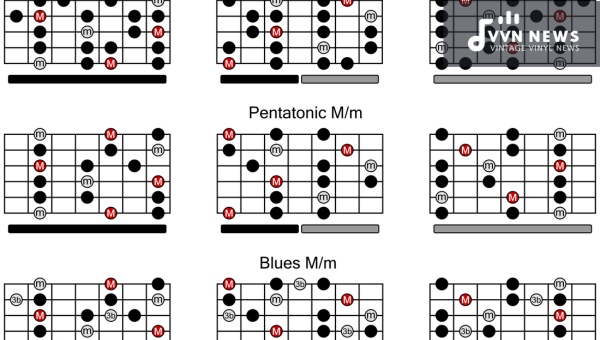
When delving into the blues scales in the key of A, it’s crucial to note the differences between the major and minor variants.
While they share a common bluesy character, their individual notes craft distinctive moods and expressions.
The A Minor Blues Scale
Traditionally evocative and deep, the A minor blues scale consists of six notes:
- A (Root)
- C (Minor Third)
- D (Perfect Fourth)
- D# (Augmented Fourth/Diminished Fifth)
- E (Perfect Fifth)
- G (Minor Seventh)
This is built on the natural minor scale but with an added chromatic “blue” note—the D#, creating that signature bluesy sound.
This note is vital; it’s the dissonant heart that bleeds emotion into your music.
The A Major Blues Scale
On the flip side, we find the brighter sound of the A major blues scale:
- A (Root)
- B (Major Second)
- C# (Major Third)
- D (Flat Fifth/Blue note)
- E (Perfect Fifth)
- F# (Sixth)
Notice how this major variant introduces a different blue note—the D—which contrasts with its minor counterpart’s use of D#. It presents a sweeter, yet still soulful color to melodies.
Seamlessly switch between these scales during solos or compositions, channeling either somber depths with minor progressions or uplifting vibes with major melodies – adding dynamic versatility to your blues repertoire.
Also Read: 25 Best Hip-Hop Producers [Behind The Beats Of The Hits]
What Tracks Are Best for Practicing the A Minor Blues Scale?
Practicing the A Minor Blues Scale often involves jamming along with tracks that highlight the scale’s evocative sound.
Here are some essential tracks in A Minor that will not only enhance your skills but also immerse you in the blues vibe:
- “The Thrill is Gone” by B.B. King
This classic tune is a gateway to blues improvisation. Its slow tempo and clear structure offer ample space to experiment with the A minor blues scale. - “Red House” by Jimi Hendrix
Another blues staple, “Red House,” gives guitarists and other musicians a rich tapestry of chords in A minor to solo over using the blues scale.
By practicing over these tunes and more, you’ll not only cement your fluency in the A minor blues scale but also absorb some of blues‘ quintessential feels and expressions.
Each track offers unique challenges that will help develop both technical proficiency and emotional depth in your playing.
The Significance of Ear Training in Mastering A Minor Blues Scales

As a musician delving into the emotive world of blues, it becomes quickly evident that ear training is invaluable when aiming to master the A Minor Blues Scale. Here’s why:
- Essential for Improvisation: The blues is an improvisational music form at its heart. Training your ear helps you anticipate chord changes and weave scale notes creatively, allowing for more dynamic playing.
- Recognize Patterns by Sound: Learning how the scale ‘sounds’ aids in identifying patterns and licks commonly used in blues music, making it easier to replicate and innovate on the fly.
- Develop Musical Intuition: Beyond mechanical practice, ear training develops intuition, helping musicians to feel where a song is going. It fosters an instinctual understanding rather than just a technical one.
- Accurate Pitch Reference: You’ll be able to maintain consistent pitch without relying on visual cues from your instrument. This sharpened sense ensures you are perfectly in key when applying the scale.
- Enhance Relative Pitch: Ear training boosts your ability to determine intervals between notes. Particularly crucial as the blues scale includes non-standard pitches like the flattened fifth, or “blue note.”
- Improve Timing and Rhythm: Internalize swing rhythms that are quintessential to blues by recognizing and matching rhythmic patterns just by listening.
Practicing with backing tracks specifically tailored for A Minor Blues scales, or analyzing recordings where these scales are prevalently used, can greatly enhance ear training efforts.
Sharpened auditory skills mean less fumbling through positions and more soulful expression as you unlock the full potential of this timeless scale.
Songs that use the A Minor Blues Scale
The A minor blues scale, with its distinct sound, has graced countless songs across various genres.
Its expressive quality allows musicians to infuse a song with an emotional depth that resonates with audiences.
Below are some iconic tracks that masterfully utilize the A minor blues scale:
- “The Thrill Is Gone” by B.B. King
An anthem in the blues world, this song features King’s virtuosic guitar work that is almost entirely based on the nuances of the A minor blues scale. The slow-burning lead lines speak volumes of heartache and loss. - “Red House” by Jimi Hendrix
Jimi Hendrix’s “Red House” is a masterclass in blues, weaving the A minor blues scale throughout its mesmerizing guitar solos. Its raw energy and emotion showcase the power of the scale when executed with passion. - “Stairway to Heaven” by Led Zeppelin (solo)
The legendary solo of this rock classic dips into the A minor blues scale, adding a layer of complexity and feeling amid the song’s climactic build.
Exploring these tracks can offer you insight into how versatile and emotionally charged the A minor blues scale can be.
As you listen, pay attention to how each artist applies subtle bends, vibrato, and phrasing to bring out the essence of this scale.
The common thread among these songs is not just their use of similar notes but also how each artist transforms those notes into something wholly unique and expressive within their musical context.
Also Read: 25 Best Singers Of All Time [Voices That Made Music History]
FAQs Related to the A Minor Blues Scale
What is the unique note in the A Minor Blues Scale that gives it a bluesy sound?
The blues note in the A Minor Blues Scale is the E-flat (or D-sharp), which adds that distinctive bluesy feel.
Can I use the A Minor Blues Scale over any chord progression?
Yes, you can use it over any progression that’s in the key of A minor, particularly over Am and E7 chords for a classic blues sound.
What is the difference between A Minor Pentatonic and A Minor Blues Scales?
The A Minor Blues Scale includes an additional blues note (E-flat/D-sharp) whereas the Pentatonic does not.
Is it necessary to learn all five shapes of the A Minor Blues Scale?
While not necessary, learning all five shapes gives you more flexibility and freedom to improvise across the fretboard.
How can I practice phrasing with the A Minor Blues Scale?
Practice playing short licks and phrases by emphasizing bends, vibrato, and timing to express emotion within your solos.
Conclusion
The A minor blues scale is a versatile and emotive tool that can elevate your musical expression.
Whether you strum a guitar or tickle the ivories, mastering this scale opens up a rich bluesy palette to color your performances.
Remember to practice regularly, listen carefully to blues legends for inspiration, and most of all, enjoy the soulful journey that the A minor blues scale facilitates.

